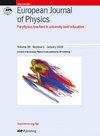利用 Mathematica 实现圆形波导中电磁场的可视化
IF 0.8
4区 教育学
Q4 EDUCATION, SCIENTIFIC DISCIPLINES
引用次数: 0
摘要
本文采用 Mathematica 对圆波导中的电磁场(EMF)进行可视化,有效地解决了与理论抽象和计算复杂性相关的教学难题。我们首先推导出引导模式的精确解,然后总结了使用 Mathematica 实现电磁场可视化的步骤,提出了教学策略,并展示了仿真结果。我们提供了 Mathematica 代码,允许动态调整参数和实时观测场变化。这种方法通过引人入胜的可视化和互动学习体验,大大增强了本科生对电磁学的理解。本文章由计算机程序翻译,如有差异,请以英文原文为准。
Visualization of electromagnetic fields in a circular waveguide using Mathematica
This paper employs Mathematica for visualizing electromagnetic fields (EMF) in circular waveguides, effectively addressing pedagogical challenges related to theoretical abstraction and computational complexity. We first derive the exact solutions for guided modes, then summarize the steps for visualizing EMF using Mathematica, propose educational strategies, and showcase simulation results. The Mathematica code is provided, allowing for dynamic parameter adjustment and real-time field change observation. This approach significantly enhances undergraduate students’ understanding of electromagnetism through engaging visual and interactive learning experiences.
求助全文
通过发布文献求助,成功后即可免费获取论文全文。
去求助
来源期刊

European Journal of Physics
物理-物理:综合
CiteScore
1.70
自引率
28.60%
发文量
128
审稿时长
3-8 weeks
期刊介绍:
European Journal of Physics is a journal of the European Physical Society and its primary mission is to assist in maintaining and improving the standard of taught physics in universities and other institutes of higher education.
Authors submitting articles must indicate the usefulness of their material to physics education and make clear the level of readership (undergraduate or graduate) for which the article is intended. Submissions that omit this information or which, in the publisher''s opinion, do not contribute to the above mission will not be considered for publication.
To this end, we welcome articles that provide original insights and aim to enhance learning in one or more areas of physics. They should normally include at least one of the following:
Explanations of how contemporary research can inform the understanding of physics at university level: for example, a survey of a research field at a level accessible to students, explaining how it illustrates some general principles.
Original insights into the derivation of results. These should be of some general interest, consisting of more than corrections to textbooks.
Descriptions of novel laboratory exercises illustrating new techniques of general interest. Those based on relatively inexpensive equipment are especially welcome.
Articles of a scholarly or reflective nature that are aimed to be of interest to, and at a level appropriate for, physics students or recent graduates.
Descriptions of successful and original student projects, experimental, theoretical or computational.
Discussions of the history, philosophy and epistemology of physics, at a level accessible to physics students and teachers.
Reports of new developments in physics curricula and the techniques for teaching physics.
Physics Education Research reports: articles that provide original experimental and/or theoretical research contributions that directly relate to the teaching and learning of university-level physics.
 求助内容:
求助内容: 应助结果提醒方式:
应助结果提醒方式:


